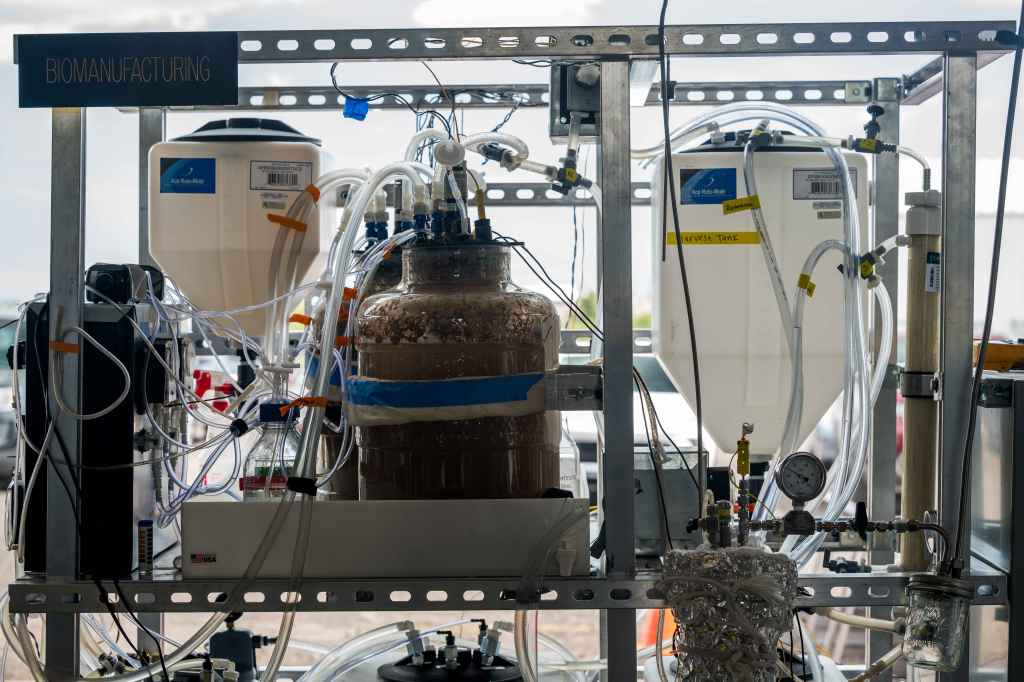‘Waste to value’: Inside cutting-edge DARPA efforts to make food out of trash and gasses

This Summer at the NATO to the Future micro-summit in Washington, Defense Advanced Research Projects Agency Director Stefanie Tompkins was asked onstage by longtime journalist Steve Clemons to share her favorite “cool new technology thing” the Pentagon’s research arm is developing under her leadership.
She responded: “I mean, the stuff that just catches everyone’s imagination is we want to make stuff that we’ll need where we are going to need it — so making food out of plastic, or food out of thin air.”
Although the DARPA chief did not provide additional details then, a spokesperson later confirmed that Tompkins was referring to two different programs that fall within the agency’s Biological Technologies Office: Cornucopia and ReSource.
Experts involved with Cornucopia are working to enable the on-demand production of appetizing, microbial-origin food using water, air, and electricity. Those participating in ReSource are pursuing efforts to make food and other products (like lubricants, adhesives, tactical fibers, and potable water) from plastics and other military waste.
In recent, separate interviews, the two program managers overseeing Cornucopia and ReSource briefed DefenseScoop on their teams’ latest research findings and results. They each also highlighted how this work contributes to an overarching DARPA mission to help “de-risk logistics” associated with supplying food and other key items to troops in remote and dangerous locations.
“We’re always concerned about the warfighter, and there’s this whole concept of what we call contested logistics — and having access to materials at the point of need is a huge issue,” Dr. Leonard Tender, who leads ReSource, told DefenseScoop.
Cornucopia
Putting it simply, bio-manufacturing and bio-technologies are associated with a broad range of techniques, processes, and capabilities that use living organisms or biological systems to generate various products.
“I think a lot of people focus on bio-manufacturing as making small molecules. But food is a product, right?” Dr. Matthew Pava, the DARPA program manager in the biotechnology office who oversees the Cornucopia effort, told DefenseScoop.
“Cornucopia is sort of envisioning an opportunity to create food — maybe from a less obvious source — which is microorganisms,” he explained.
The greater aim of the program, according to Pava, is to demonstrate a system that can produce a “biomass” within a 24-hour period that can serve as a food source to sustain 14 warfighters for a single day.
“So the idea on this program is to stick, essentially, gasses — like air, that contains some carbon dioxide, a lot of nitrogen, or an exhaust stream from something like a generator, which you’re probably going to have in a [deployed situation]. Placing those gas sources into chemicals like microorganisms, simple organic molecules, sugars — performers are taking different approaches to that — but that’s where the system starts. And then the sugars need to basically get consumed by the organisms that ultimately will be your biomass,” Pava explained.
When it first launched several years ago, Cornucopia was designed to answer fundamental research questions about whether it is possible to use such engineered microorganisms to grow a biomass (or constellation of cells) that was edible — flavorful — and could sustain military personnel.
As the first phase of the program was being conducted, researchers involved initially focused on synthesizing flavor molecules to generate a “super tasty biomass, where we could tune a flavor profile to be whatever you wanted it to be,” Pava said.
“What was found in the first part of the program is that, first of all, that’s a really, really hard problem. Because what gives food flavor is not usually singular molecules, but it’s a profile of a large set of molecules in a very particular ratio with one another,” he said.
Therefore trying to engineer the metabolism of an organism to very precisely tune the production of each one of those molecules and get that right each and every time “is a pretty significant challenge in and of itself,” the program manager explained.
Further, the organisms don’t just produce the flavor molecules that humans want them to — they also create other molecules for their own metabolism and individual purposes, which can create off-putting flavors.
Based on such learnings in phase 1, those involved re-scoped Cornucopia to create a “blank-space” biomass that contains all the macro- and micronutrients warfighters need to be considered “nutritionally complete” by operation standards and has no taste until flavor molecules are introduced.
“And the reason why the blandness is important is because it’s really not so difficult to add flavor. It’s a lot harder to take flavor out of something. You can think about if you over-salt the soup that you’re making. To take the salt back out of the soup is a little bit more challenging than if you were adding more salt to it,” Pava said.
An example of how this work “might play out,” he added, is that teams involved could create a healthy biomass powder that can transform into a food product — “like a pudding, or shake, or jerky,” as Pava put it — and then adding “a flavor packet” to it that inspires the flavor profile or taste of a specific dish.
The scientist noted that actually creating solid food items with texture like jerky would be extremely difficult. However, Pava noted, DARPA’s “intention is to shift possible.”

He and his colleagues engaged with Army Soldier Centers and others developing food rations for the military to inform their work. One element that really stood out to Pava in those conversations was how much food’s purpose “isn’t just sustaining the warfighter — but it’s also a comfort,” he said.
“So there’s this important psychological aspect of it as well, which is really why food is sort of a complicated topic. You could imagine somebody that has to operate abroad in tough circumstances, and they’re relying on a platform to produce food for them. It would be ideal if, in a moment, they could say, ‘Today, I really feel like eating something that tastes like chicken or eating something that tastes like beef,’” Pava told DefenseScoop.
While what DARPA is trying to make would be healthier, he likened the aims to contemporary ramen noodle dishes that come with various packs of flavor powders.
“From a repurposability standpoint, I can make that taste like many, many different things, but ultimately it’s the same product that you need,” Pava said.
DARPA has two teams on contract for Cornucopia: one from SRI International, and the other from the University of Illinois, Urbana. While the originally planned program was structured across three stages, it was re-scoped down to only two. The second phase recently kicked off and there’s about one-and-a-half years left of work anticipated in the pursuit.
“One of the other things that we added in phase 2 is the revised tasking for our performers. We’re now asking them to seek [Food and Drug Administration] certification … that will greatly facilitate the ability of doing a human study, to taste this biomass” down the line, Pava said.
ReSource
DARPA’s ReSource effort, which recently concluded after unfolding over the last four years, broadly encompassed work to create “on-demand” products — like lubricants, adhesives, tactical fibers, potable water, and edible macronutrients — on the battlefield by engineering them in self-contained units from feedstock collected there, onsite.
In a recent interview, Leonard Tender, the program manager who led ReSource in DARPA’s Biological Technologies Office, told DefenseScoop the ultimate aim was solving “two really hard problems at once.”
“The first hard problem is: How do you deal with mixed plastic waste, paper waste in particular, which are a huge problem in general, but also for the military — especially when you’re in a forward deployed situation, or off the beaten path, and you have a lot of this material — how do you get rid of it responsibly? And a lot of times the logistics of getting that material off base and handling it requires extensive transport chains and high expenses,” Tender said.
The other difficult challenge envelops all that it takes for critical materials — and in particular, fuels, oils, lubricants and food — to be supplied into austere conflict environments.
“So the notion is that we can connect the two — and that is, convert waste materials into those useful materials. Then you’re not worrying about getting those waste materials off-site, and you’re not worrying about bringing those useful materials on-site. You’re just converting one to the other,” Tender explained.
DARPA leadership selected performer teams from Battelle, Iowa State University, Massachusetts Institute of Technology, and Michigan Technological University to support the ReSource program. Each team opted to tackle the program differently in terms of execution.
Broadly, the challenge directed those involved to explore and establish a low-power means to transform trash and no-longer-usable objects into food and other items within a self-contained, transportable unit that is smaller than a few cubic meters, roughly the size of a pickup truck.
When asked by DefenseScoop what the simplest way to describe this work would be, Tender said: “We’re converting waste to value.”
“It’s very exciting to be at this point and to actually see these ideas come to fruition — at least, in the prototype form — where we actually have these built-out shipping containers, essentially that are doing the process and we actually feed in the waste one side and at the other side, you can imagine, like a spigot, where you know your outcomes are oil, your lubricant, or pancake-like bacteria that can be used by itself or to supplement food,” he explained.

On the heels of this success, the agency is now exploring transition opportunities for the technologies developed — and engaging with potential sponsors involved in more advanced research development who’ve expressed interest in driving further innovation around these concepts.
Many DARPA programs result in new technologies, concepts, and development pathways via the commercial sector for dual-use capabilities.
“The ability to convert waste materials into single-cell protein, for example, could be very impactful in the commercial sector. And so our teams are working with entrepreneurs to do that,” Tender explained.
“DARPA doesn’t like to make products that people go and buy. Our goal is to sort of de-risk the original concept — and we have done that,” he added.
De-Risking at DARPA
As the Defense Department’s top research and development hub, DARPA is deliberate and strategic about de-risking new technologies and emerging concepts to motivate the private sector and others to invest in further product development.
“Taking the de-risk idea, we think in terms of technology readiness levels, or TRLs. So at DARPA, it very typically starts at a very low number, where someone has sort of a glimmer of an idea and might have a couple of results from literature that says it’s possible, but it’s never been really attempted — then to take it to a higher level idea where you kind of like demonstrated it in a prototype form, and that’s where we are right now” with ReSource, Tender said.
“And then there’s other sponsors to take it from the prototype form out to something that can actually be implemented, provided to the warfighter or commercialized. And so we have a lot of interest from those follow-up transition partners,” he noted.
Pava, Cornucopia’s program manager, put it another way: “Being DARPA, we’re trying to de-risk that first, critical, super hard step, and then we’re going to need to bring in transition partners [from across the military] that we hand the baton off to.”
In their separate conversations with DefenseScoop, both program managers suggested that their teams are taking an aggressive approach to de-risking solutions that might be useful in addressing significant military logistical burdens.
“Getting food to the warfighter, especially if they’re in a location that has a very, very long logistic tail associated with it, is a challenge,” Pava said.
He noted the power of potentially enabling new capabilities that could lead to one day having modular units that could be deployed alongside service members to provide food and sustenance at the precise place where it’s required.
“So, you could capture carbon from air or gaseous waste, like generators’ exhaust, you can pull nitrogen out of the air and fix that and then grow up a biomass on that carbon or nitrogen, for instance, as opposed to having to ship pallets, on pallets, on pallets of [Meal, Ready-to-Eats or] MREs to tier warfare, which might not be possible,” he said.
“It’s not [about] ‘sustainment,’ I think, as we typically think of sustaining large infrastructure. But it’s sustaining our people in very particular circumstances where we’re asking them to do really hard and dangerous stuff,” Pava added.
In a recent email after the interviews were conducted, DARPA Director Stefanie Tompkins told DefenseScoop that the agency is also thinking seriously about supply chain resiliency from multiple different angles — and that’s “all driven by our program managers” like Pava and Tender.
“Along with making food, extracting water, and producing medicine when and where we need it, we’re modeling complex global supply chains to understand where the weaknesses are. And when there are things we just can’t make at the point of need, we’re looking at new ways to revolutionize delivery and transport,” Tompkins said.




